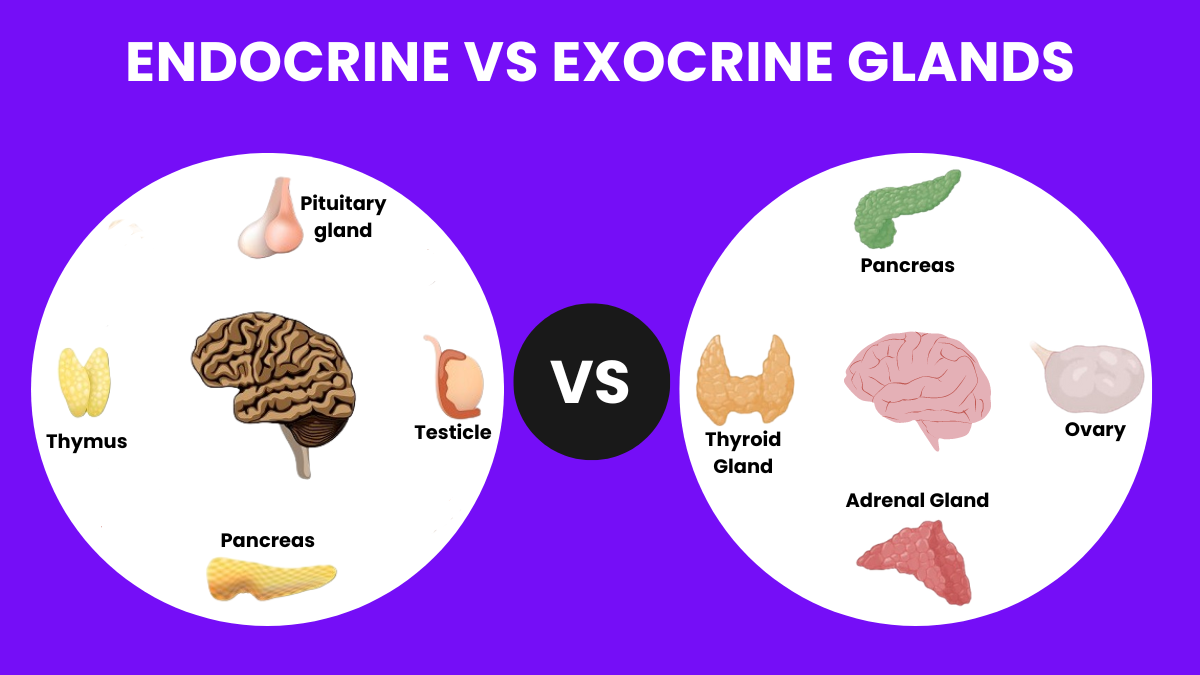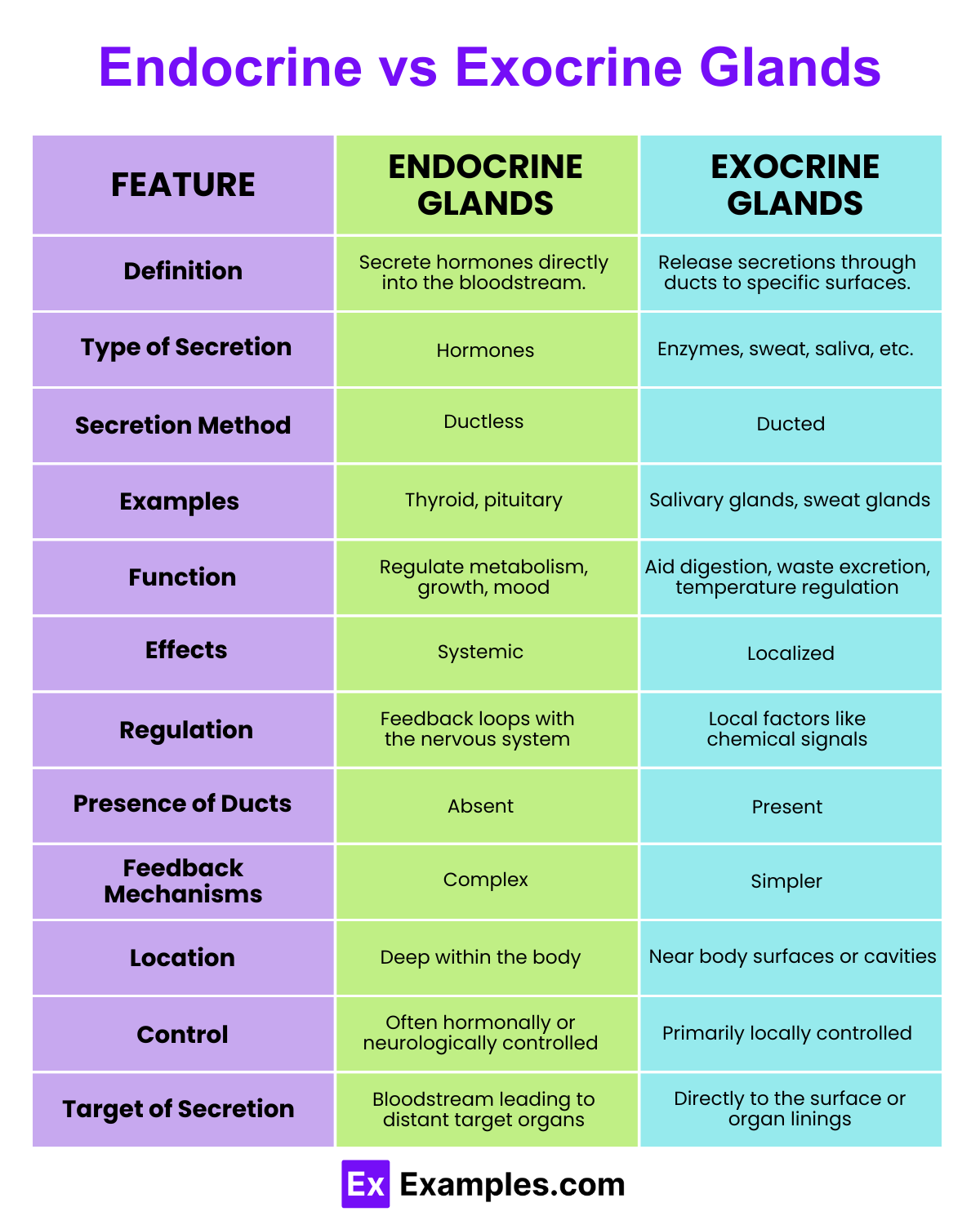Which of the following glands is an endocrine gland?
Salivary gland
Thyroid gland
Sweat gland
Sebaceous gland


Glands are essential cell units that produce and release substances either into ducts or directly into the bloodstream. There are two main types: exocrine and endocrine glands. Exocrine glands secrete their products, such as enzymes and sweat, through ducts to external or internal surfaces. Conversely, endocrine glands release hormones directly into the bloodstream, facilitating broad and efficient regulation of bodily functions like growth and metabolism. This distinction in secretion pathways underscores their differing roles in the body.
Endocrine glands are vital structures within your body that produce and release hormones directly into the bloodstream. Unlike exocrine glands, which secrete substances through ducts to external surfaces, endocrine glands are ductless. The hormones they release regulate various bodily functions, including growth, metabolism, and mood.
Exocrine glands are specialized cells that produce and release substances through ducts onto the external surfaces of your body. These substances include sweat, tears, saliva, milk, and digestive juices, all essential for various bodily functions. Exocrine glands differ from endocrine glands, which release hormones directly into the bloodstream without using ducts.

| Aspect | Endocrine Glands | Exocrine Glands |
|---|---|---|
| Definition | Glands that release hormones directly into the bloodstream, without using ducts. | Glands that secrete substances onto epithelial surfaces, through ducts. |
| Type of Secretion | Hormones | Various substances including enzymes, sweat, and saliva |
| Examples | Thyroid, pituitary, adrenal glands | Sweat, salivary, mammary glands, and pancreas (also has endocrine function) |
| Method of Secretion | Hormones are released directly into the blood and transported to target organs | Secretions travel through ducts to the surface of the organ or outside the body |
| Types of Hormones/Secretions | Steroid hormones, peptides, and amines | Digestive enzymes, sweat, mucus, and milk |
| Regulation | Typically regulated by feedback mechanisms sensitive to the conditions they are correcting | Often regulated by local conditions such as presence of substrates or neural signals |
| Function | Regulate various physiological processes including metabolism, growth, and mood | Aid in digestion, lubricate and protect surfaces, cool the body |
| Control | Controlled by the hypothalamus and feedback from the body’s needs | Controlled by nervous or hormonal signals specific to the gland’s location and function |
| Feedback Mechanisms | Utilizes negative feedback to maintain homeostasis | Feedback mechanisms are less common but can include local reflex arcs |
| Cellular Structure | Generally composed of secretory cells organized into clusters or follicles | Composed of secretory units with associated ducts that lead to the target surface |
| Targeting | Hormones have specific target organs and cells throughout the body | Secretions are usually targeted to specific locations, such as skin surface or gastrointestinal tract |
| Impact on Body | Broad, often affecting the entire body or multiple systems | Localized effects, typically affecting only the area near secretion |
| Examples of Disorders | Diabetes, hypothyroidism, growth disorders | Acne, cystic fibrosis, pancreatitis |
| Study Field | Endocrinology, which deals with the study and management of glandular and hormonal disorders | Often studied under gastroenterology, dermatology, and other specialized fields dealing with organ systems |
Endocrine and exocrine glands are integral to the body’s ability to function and maintain balance. Despite their different modes of secretion, these glands share several important similarities:
Both endocrine and exocrine glands originate from epithelial cells, which line the cavities and surfaces of structures throughout the body. These glands are essentially clusters of cells that work together to produce and release substances essential for bodily functions.
Both types of glands are responsible for secreting substances crucial to health and well-being. Endocrine glands release hormones that regulate various physiological processes, while exocrine glands secrete non-hormonal substances like enzymes, sweat, and saliva that play key roles in digestion, temperature regulation, and other bodily functions.
Both gland types are regulated by feedback mechanisms that ensure the proper functioning of the substances they release. For example, hormone levels from endocrine glands are often controlled by feedback loops that involve the brain and other glands, ensuring that the right amount of hormone is always circulating. Similarly, exocrine secretions are often regulated by local factors or nervous system control to meet immediate physiological needs.
Endocrine and exocrine glands significantly contribute to maintaining homeostasis—the body’s state of steady internal, physical, and chemical conditions. By releasing their respective substances, these glands help balance and regulate conditions within the body to keep it functioning optimally.
Both types of glands are distributed throughout various organs and tissues in the body. From the skin and pancreas to the thyroid and adrenal glands, these structures are essential everywhere, indicating their integral role in overall health.
Endocrine glands and exocrine glands are two distinct types of glands in the human body that play crucial roles in the regulation of bodily functions through the secretion of substances. They differ fundamentally in their structure, function, and the methods by which they release their products. Understanding these differences is essential for grasping how the body maintains its internal balance and responds to its environment.
Endocrine Glands:
Exocrine Glands:
Endocrine Glands:
Exocrine Glands:
Endocrine Glands:
Exocrine Glands:
Endocrine Glands:
Exocrine Glands:
Endocrine Glands:
Exocrine Glands:
Endocrine glands release hormones directly into the bloodstream, while exocrine glands secrete substances through ducts to external surfaces.
An example of an exocrine gland is the salivary gland, which secretes saliva into the mouth.
The thyroid is an endocrine gland, producing hormones like thyroxine that regulate metabolism.
Endocrine glands secrete hormones directly into the blood, e.g., pituitary and adrenal glands. Exocrine glands use ducts to release substances externally, e.g., sweat and salivary glands.
Text prompt
Add Tone
10 Examples of Public speaking
20 Examples of Gas lighting
Which of the following glands is an endocrine gland?
Salivary gland
Thyroid gland
Sweat gland
Sebaceous gland
Exocrine glands release their secretions:
Directly into the bloodstream
Into ducts that lead to target areas
Into lymphatic vessels
Through diffusion
Which of the following is NOT an endocrine gland?
Pancreas
Pituitary gland
Adrenal gland
Mammary gland
What is a primary function of endocrine glands?
Secrete enzymes
Release digestive juices
Produce hormones
Lubricate body surfaces
The pancreas has both endocrine and exocrine functions. Its endocrine function involves:
Secreting bile
Releasing digestive enzymes
Producing insulin and glucagon
Excreting sweat
Which gland is responsible for secreting digestive enzymes into the small intestine?
Pancreas
Thyroid gland
Adrenal gland
Pituitary gland
How do endocrine glands typically release their hormones?
Through ducts
By direct cell contact
Into the bloodstream
By exocytosis into body cavities
Which of the following is a characteristic of exocrine glands?
They lack ducts
They release hormones into the blood
They secrete substances onto epithelial surfaces
They control metabolic activities
Which gland functions exclusively as an endocrine gland?
Liver
Parathyroid gland
Pancreas
Salivary gland
Sweat glands are an example of:
Endocrine glands
Exocrine glands
Both endocrine and exocrine glands
None of the above
Before you leave, take our quick quiz to enhance your learning!

